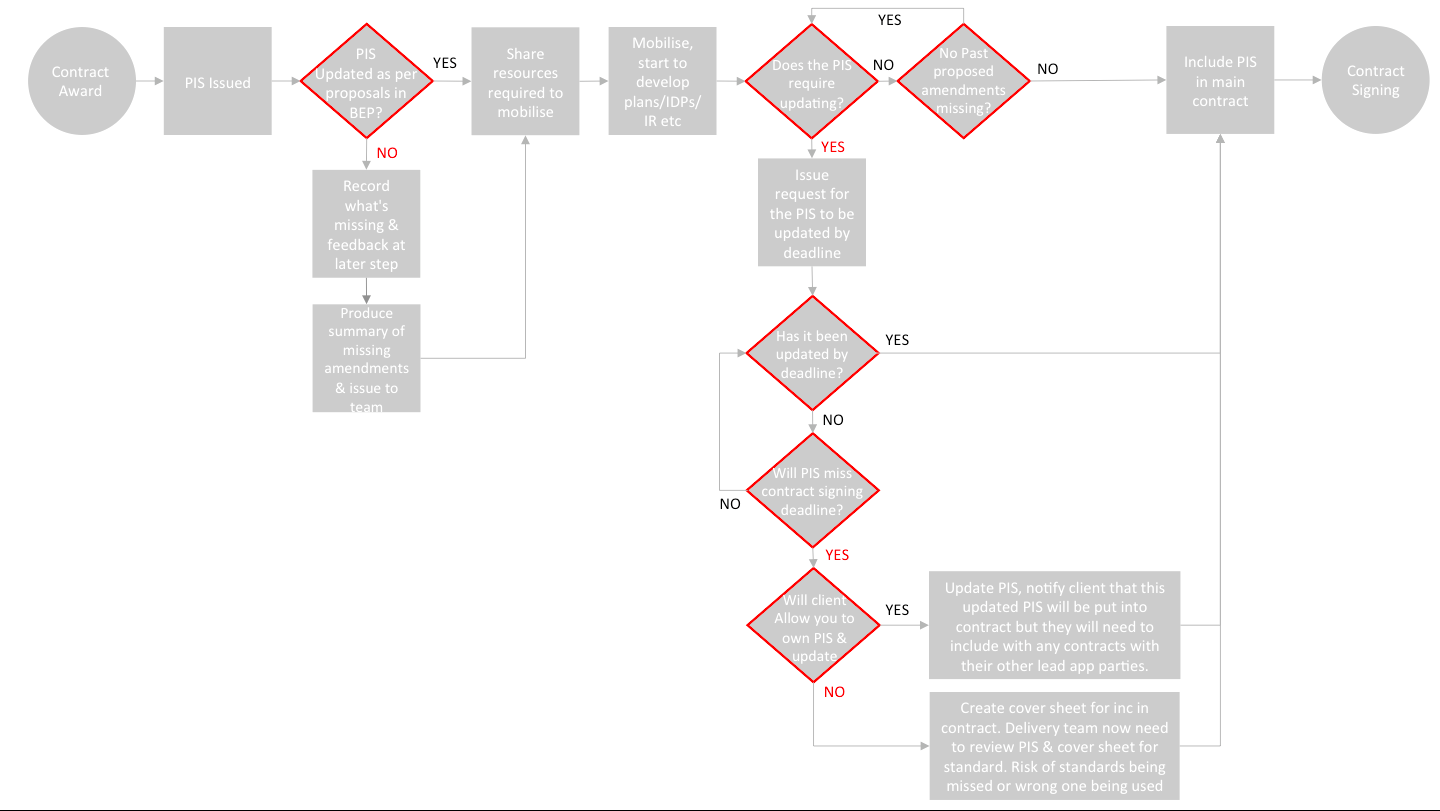
Galliford Try construction group BIM and digital delivery lead John Ford shares his experience of moving from PAS 1192 to ISO 19650.
For me, 2022 is the year when many of the major public sectors began the transition from the withdrawn PAS 1192 information management principles to the current ISO 19650 standards. I have seen some really well thought out, comprehensive information requirements for the first time that are sure to test the limits of digital capability.
I hope this piece will be one of several that provide insight into some of the challenges in adopting the latest ISO 19650 standards. I know some who believe the transition from the PAS 1192 to ISO 19650 standards is relatively easy and in some cases requires no changes other than terminology.
From a high-level process perspective, they are somewhat right, as there are more similarities than differences, but, as with everything information management, the devil is in the detail.
Here I look at the challenges related to the Project’s Information Standard.

“Once awarded a contract under ISO 19650, there are three main differences many people may not realise and may underestimate the impact on mobilisation.”
The Project’s Information Standard is an ISO 19650 defined, project-wide information management resource (not appointment-specific) that clients must develop and own throughout the project’s life. They can of course also delegate those duties to parties in the project team – but that can be said for anything.
As many of you may know, under PAS 1192-2, lead suppliers (like main contractors) during the tender stage would have to propose how they will do something and propose any new standards or changes to existing ones defined by the client. The same goes for ISO 19650. You are required to submit any proposed amendments during the tender process.
However, once awarded a contract under ISO 19650, there are three main differences many people may not realise and may underestimate the impact on mobilisation. If it wasn’t for the hard work of our pioneering project teams that wanted to do it right and didn’t accept half-measures, it may have just been left to deal with later, which is wasteful at best, damaging to the programme at worst.
I use the main contractor as my primary example below, but any entity that falls under the definition of ‘Lead Appointed Party’ would be applicable. The three key differences are:
- The ISO 19650 BIM Execution Plan (BEP) is not the same thing as under PAS 1192-2 ‘Post Contract BEP’: it isn’t an answer to most of the questions the main contractor and their team need answering, like “what standards should I use and how?”
- The Project’s Information Standard, which didn’t really exist under PAS 1192 (almost everything was appointment-specific), is actually where the main contractor’s team and every other delivery team need to find answers to the example question above. By “every other delivery team”, I mean that if it’s a traditional contract, for example, the client’s consultants and client’s main contractor should work from this single resource, even if that resource contains information not relevant to either of their scopes/packages. There is logic in this approach, but it has some challenges as I will explain.
- Under PAS 1192, the BEP was owned by the main contractor or lead supplier and any minor update, like an additional format requirement the supply chain must satisfy, could be done without disrupting or involving the client (or at the very least there would be a simple variation request put forward for acceptance): this is not the case under ISO 19650.
The Project’s Information Standard that now replaces the BEP in defining all project standards is owned by the client and the main contractor cannot, unless given this authority, directly update this resource and would have to wait on the client to review and action that request.
This could include the possibility of the client then needing to obtain comments from potentially dozens of other stakeholders that this Project’s Information Standard is bound to via appointments before they can update this resource and formally rebind into appointments and/or share via the common data environment to their supply chain.
This is a far lengthier process than under PAS 1192-2, which could be managed by a simple RFI, TQ or variation request leading to the BEP being updated if required. In addition, any clients that don’t have a good handle of this process may be unaware of this requirement, as ISO 19650 doesn’t make it clear that this can and often is an iterative and developing resource, being updated potentially several dozen times, all of which require wider project input and comment.
Minor and major changes
There are times when some changes will be minor and some major.
“This is a far lengthier process than under PAS 1192-2, which could be managed by a simple RFI, TQ or variation request.”
Major changes proposed by a lead supplier like a main contractor should always require the client to obtain project-wide approval. An example could be the cost consultant proposing, mid-design, to change IFC’s exchange version from 2×3 to IFC4 because the cost consultant’s new tool can do some fancy new stuff not supported by 2×3. This could impact the supply chain considerably if that project information standard was issued out formally as an addendum to all delivery teams without scrutiny.
Examples of a minor change could be that you want to expand on naming convention form codes as allowed within the 2021 addendum of ISO 19650-2, whereby you can add a suffix to extend the codes. As an example, the Project’s Information Standard only allows ‘M’ for models, but you want to split for 2D and 3D models and thus have proposed M2 and M3, as was typical under BS/PAS 1192. The main contractor in this instance can’t just update this standard or update a simple table that was once in their BEP that governed naming: they would have to request the project standard be updated by the client before they can reissue to their delivery teams. The client would also need to seek wider input.
Regardless of minor or major updates, both require the client to update resources that once were managed by their lead suppliers and so everyone is now waiting on the client to complete this before they can proceed. This type of waiting didn’t really happen under PAS 1192 as the main contractor would have updated its BEP and simply asked the client to review and accept as per project contract allowances with all administration being taken care of by the contractor. And unless it has delegated this duty for continuous monitoring, collaboration and updating of project-wide resources to a qualified party as is allowed under ISO19650, this can result in programme delays.
Below is a process diagram to illustrate the problem we faced shortly after a contract award, whereby we only had a few weeks before the contract had to be signed to get all resources complete for the contracts to be finalised. It doesn’t cover mobilisation where you also have issues as you start to notice further changes are required as testing of standards result in unforeseen challenges.

All the decision boxes in red were not present under PAS 1192-2, from our perspective at least, as we had a lean process in place for maintaining our resources. We simply issued an RFI for any amendments and, if accepted, we updated the BEP, which would caveat (explained in the protocol) any outdated statements in the client’s resources and then we rebound it to appointments that very same day.
This also made it easier for the client as many clients want the least amount of paperwork to do themselves. And even if they did delegate the information management role, was it made clear to that delegate that they could be updating this 20-plus times a year or did they only provide allowances for two updates (which is what we found with one of our projects)?
The above process helped us understand the snags, so we could propose solutions (read on).
The obvious questions
Those familiar with ISO 19650 and who have an opinion on this may be asking a few questions at this point.
I thought ISO 19650 only required you to list proposed amendments in the BEP?
The proposed amendments for the pre-appointment BEP, yes. The appointment BEP that’s about to go into a contract cannot have proposals: it must have agreements. You can propose all you like and then use that for your RFI or variation request (although it’s a bit of overkill and hard to read), but you must have it agreed for a contract, and agreements must be captured in the Project’s Information Standard, which is bound alongside the BEP in the appointment. So be wary if the BEP has proposals but those proposals are not in the Project’s Information Standard. You can of course consider placing something in between them that says the BEP proposals take precedence over section x,y,z of the Project’s Information Standard as agreed on dd/mm/yy via RFI 999, etc.
Why can’t you just continue with the RFI process, and if the client doesn’t update the Project’s Information Standard, you just capture the agreed changes in the BEP or another place separately?
You can, but then your team have two places to find standards: they first need to read the Project’s Information Standard, which could be 30 pages long, then cross-reference with the BEP or other document for missing standard amendments. The team will become frustrated having to look in multiple places as this was our initial solution.
Lessons learned
Here are some lessons we learned to help mitigate these challenges on our next projects – you may approach them differently of course:
- During the tender process, issue a Technical Query (unless you know the answer) and ask the client who will be updating the project-specific resources following contract award and whether they foresee a time delay, e.g. they have a third party planned but won’t be assigned until award, which means you’re waiting for a third party to be onboarded before the resource is updated. Knowing this will allow you to plan for these challenges prior to mobilisation, not during, which is very disruptive.
- If the client says they don’t have anyone, either raise the risk and propose a scope they can assign to someone or offer the client to take ownership of the resources on their behalf. We often did this as standard under PAS 1192 anyway for our appointment resources. The only challenge is the cross-referencing with all the client’s other stakeholders, which often didn’t happen, but has to under ISO 19650 and so is likely to take more time and resource to complete. If it was a purist ISO 19650 project, the client should have assigned the update of this resource and others like the project’s method and procedures to someone before parties like us are engaged as it is a requirement.
- Record in the risk register along with the mitigation. If we go round in circles and get no updated resources, either notify the client that there is a risk and what our solution is to avoid compensation events occurring, which nobody likes, e.g. we are going to take your project resource, amend it (if in Word format or convert it ourselves), and submit this amended version for your review and acceptance within 14 days. This version, including an updated revision will supersede their revision. We have to do this because we can’t wait on things that affect delivery today. This helps the client by lessening their workload and helps us move forward quickly.
- Help inform clients early about these kind of challenges and provide guidance as early as possible if you have the opportunity.
So the key message is:
- Keep an eye on the fact that several of the information management resources are no longer specific to your appointment, they are project-wide. If you have overlooked the guidance above, there is always the risk that any mitigation you may have applied within your appointment maybe in contradiction to the project-wide objective and benefit.
- And if you’re in the position of client, or can support clients, try to bottom this out before contracts are awarded, especially if the point between award and appointment is short.
Don’t miss out on BIM and digital construction news: sign up to receive the BIMplus newsletter.
Comments
Comments are closed.












I have this problem on a recent education bid. We need lots of updates to be applied but none have been made which is a problem because the updates are not going into our sub-contracts until they are approved. So a raft of paperwork will have to be revised. I much preferred the old approach as it was all in the BIM Plan, hence the name, where all standards, responsibilities etc were found.
We just have 3x more paperwork to deal with now.
Thank You!
After reading this I thought I would check one of our recent wins for a school that uses 19650 and low and behold none of the proposals, mainly around naming were incorporated and updated and that we didnt seem to notice it either and so our contracts & latest drawings are not using the proposed amendments which are quite necessary!!
So it seems our teams were willing to accept half measures!